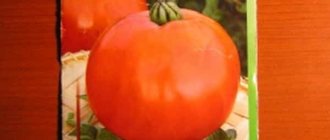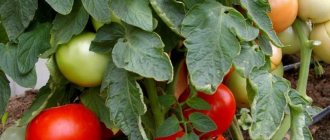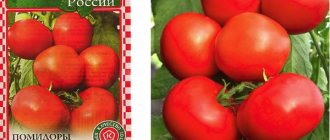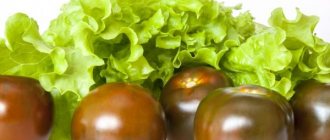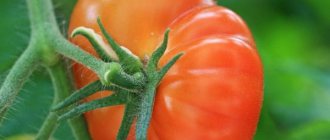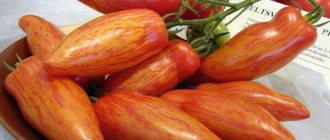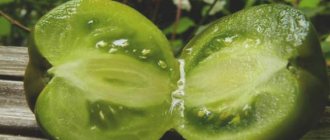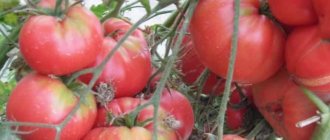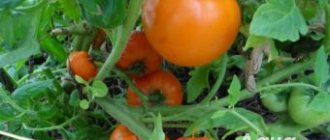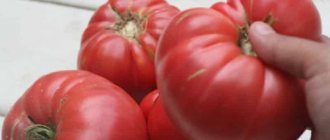Description of the Buratino variety
According to the ripening period, tomatoes are classified as mid-early varieties. They adapt well to any climatic conditions in Russia. Tomatoes are not afraid of hot, dry summers and cold winter conditions. Pinocchio is well suited for growing in open soil, in greenhouses and greenhouses. Characteristics of bushes:
- Determinate type, which does not require the formation of bushes, installation of supports, gartering and pinching.
- The form is spreading.
- Plant height is from 60 to 80 cm.
- The number of leaves is moderate.
- The leaves have a regular shape, medium size and dark green color.
- The first inflorescence is formed above the 6-7 leaves. The following brushes appear above every second leaf.
- The stalk has no joints.
- Up to 6 fruits ripen on each cluster.
- Bushes need timely watering and lighting.
Fruit:
- The shape of tomatoes is an elongated cylinder with a spout.
- Weight on average 90 grams (sometimes more).
- The surface is smooth.
- The pulp of ripe tomatoes is dense and juicy, tastes sweet with a barely noticeable sourness.
- The skin is strong and does not crack when ripe.
- The number of seed nests is 2-3 (or more).
- Unripe fruits are light green, after ripening they acquire a bright red color, but yellow specimens are also found.
The history of the origin of the yellow Buratino tomato is unknown. It is believed that it was obtained through folk selection. Tomatoes, except for color, are practically no different from red fruits. The taste is excellent, the flesh is aromatic and juicy.
Main characteristics
The plant is compact and stocky, reaching a height of approximately 80 cm (in greenhouses). On ridges, the height usually does not exceed 60 cm. The leaves are medium-sized, dark green in color, and the leaf blades are heavily indented.
The first brush is placed above the 6th sheet, all subsequent ones go through the sheet.
The fruits form quickly, and around the 120th day you can pick the first tomatoes. The weight of tomatoes is no more than 90 grams, usually 70-80 grams. The size of the fruit and weight, as well as the presence of a dense skin, make this variety suitable for preservation in its entirety.
The pulp is tasty, juicy and very dense. There are usually no more than three chambers inside, and there are few seeds. The fruits are green at first, then, as they ripen, their skin takes on a beautiful red color. The resemblance to the nose of a famous fairy-tale character is given not only by the elongated shape of the fruit, but also by the presence of a sharp nose on the top of the tomato.
The fruits are used mainly for preservation: pickling, marinades. Buratino tomatoes are tasty fresh and can also be used to decorate dishes.
Thanks to their thick skin, canned tomatoes do not crack and “keep” their shape well. Also, these fruits store well and are suitable for long-term transportation.
Advantages and disadvantages
When comparing Buratino with other varieties, it should be noted that it has more advantages than disadvantages.
Flaws:
- When planting bushes, gardeners always count on a good harvest and apply all their knowledge and resources to this. But the fruiting of the Buratino variety is not always stable.
- Often the shape of the fruit is deformed, although the quality of the taste does not deteriorate.
Advantages:
- taste, elastic skin;
- mid-season variety;
- drought and cold resistance;
- disease resistance;
- good transportability;
- the ability to grow in greenhouses and open ground;
- preservation of fruit skins during ripening.
Choosing the right place for planting, preparing the soil well, and creating normal conditions is the task of the gardener. Compliance with these requirements will ensure a stable and abundant harvest.
Advantages and disadvantages of the variety
Experienced gardeners know that it is necessary to grow different varieties of tomatoes on the plot in order to provide the family with tasty fruits for the whole season. At the same time, both the timing and the purpose of the fruit are important. Lettuce varieties are not suitable for canning, while dense “fingers” or “cream” varieties are not as tasty fresh or cut.
Therefore, the main advantage of the Buratino variety is its versatility. Delicious fruits can be salted or canned; they are also suitable for salads. The advantages also include the following qualities of this tomato:
- mid-ripening;
- resistance to adverse weather conditions;
- excellent taste (usually fresh “cream” is inferior to its large-fruited counterparts, but the Buratino variety is good anyway);
- resistance to diseases and drought.
Tomato bears fruit abundantly in greenhouses and on ridges in the open air. Provided there is a hot summer, the fruits ripen well on the bushes even in regions such as the North-West and the Urals, although protection (non-woven materials) must also be provided in case of a sudden change in weather and cold snap.
When preserved (and this is noted by all gardeners), this variety is very tasty, and the fruits themselves look beautiful in jars. The advantages include the good yield of Pinocchio, up to 6 kg per square meter. Considering that no more than three bushes are usually grown in such an area, the tomato deserves attention not only from private owners, but also from farms.
The fruits have a shelf life and do not lose their attractive appearance during transportation. But the Buratino tomato also has several “disadvantages”:
- if improperly cared for, fruits (irregular watering, non-compliance with temperature conditions, violation of light levels) may have a deformed shape;
- the need to form a bush.
ON A NOTE!
Small Pinocchio fruits are suitable for drying and drying. The variety is often grown commercially for sale.
Proper care of tomato Buratino
The variety is intended for cultivation in open areas, but takes root well and bears fruit in greenhouse conditions. Tomatoes are planted in seedlings.
Seed preparation
It is important to consider the time of planting seeds for seedlings. The date is determined depending on the variety, location and region. Approximate time March-April.
First you need to make sure the seeds are suitable for planting. This is determined by immersing the seeds in a saline solution. The floating seeds are disposed of, the rest are prepared for sowing. First they are disinfected. To do this, immerse in a weak solution of manganese for 20 minutes. Then they are kept in a growth stimulant for up to 10 hours (use the preparations “Zircon” or “Epin”).
You can use traditional methods and take hydrogen peroxide, orthoboric acid or alcohol as a stimulant.
Growing seedlings
Sowing seeds for seedlings is no different from other varieties of tomatoes. You can buy a fertile mixture at the store or prepare it yourself. You will need to combine compost, sand, ash, garden soil and peat in a ratio of 5:2:1:5:2.
Garden soil must be disinfected with manganese solution. Before placing the mixture in the container, a drainage layer is placed on the bottom.
Seeds are sown in a common container with a height of at least 10 cm, with prepared fertile soil or in separate peat pots. The depth of burial is up to 2 cm, the distance between plantings is 3 cm. The top layer is sprinkled with water at room temperature from a spray bottle and sprinkled with a layer of peat. The containers are covered with film and placed on the windowsill in a warm place.
When 2-3 true leaves appear, the seedlings dive. A week before planting in open ground, seedlings are hardened at a temperature of + 14 C.
The transplant is carried out in two stages. In early May, the seedlings are transferred to a greenhouse, and to open ground in June. The distance between seedlings is maintained at 50 cm. Per 1 sq.m. 4 bushes are planted.
Watering and fertilizing mode
The usual requirements for caring for the Buratino variety are: regular watering, timely application of fertilizers, loosening and weeding.
- Water tomatoes twice a week at the root so as not to wet the leaves and stem. The norm is 4 to 5 liters for 1 bush. It is best to water late in the evening or early in the morning.
- The next day after watering, loosen the soil and remove weeds.
- Fertilizing is carried out once every 10-15 days with complex fertilizers. The first fertilizing is carried out immediately after planting. Then during flowering, setting and ripening of tomatoes.
- Mulch the soil under the bushes with straw or green manure.
- Do not over-moisten the soil. Excess fluid causes fungal diseases.
Preparation of planting material
After making sure of the freshness and quality of the seeds, they should be processed. You can disinfect, awaken, and speed up their germination in different ways. You can soak the seeds for 20 minutes in a weak concentration of manganese solution, keep them in biostimulants for growth (“Zircon”, “Epin”), or use traditional methods. For these procedures, hydrogen peroxide, alcohol or honey are used.
Diseases and pests
Tomato Buratino is resistant to diseases and pests. It is not affected by rot and fungi. For prevention, the bushes are sprayed with “Fundazolom” or “Ordanone”.
With abundant watering and lack of lighting in greenhouses, a black leg may appear. The disease can be identified by rotting and darkening of the roots. In this case, diseased specimens are removed and the soil is treated with 1% Bordeaux mixture.
Slugs and cabbage grass can attack the seedlings. They can be saved from the former with a solution of ammonia or metaldehyde. The cabbage plant will be repelled by the Condidor insecticide.
Disease prevention methods:
- disinfection of seeds before planting;
- compliance with crop rotation;
- regular ventilation of greenhouses;
- moderate watering;
- compliance with the feeding schedule.
One of the serious mistakes that young gardeners often make is failure to comply with the deadlines for sowing seeds and planting seedlings in open ground. This affects the development of tomatoes and their yield.
Ripening time and yield
From the first shoots to the harvesting of ripe fruits, an average of 115–120 days pass. From 1 m² you get about 6 kg of tomatoes. The fruits do not crack and are stored for a long time after harvesting. Ripe fruits are identified by their red color.
Plants tolerate dry periods well and are resistant to diseases such as verticillium and macrosporiosis.
Reviews
I don’t like planting tomatoes of the same type and inconspicuous. I want to see some kind of “zest” in the planted tomatoes. The Buratino tomato fell under the uniqueness criterion, so I decided to grow it. He is unpretentious in his care, and he was cared for very rarely. The fruits grew small with long spouts, just like Pinocchio’s. For prevention, I sprayed the plants against late blight and blossom end rot, because from year to year my tomatoes are attacked by these diseases. The harvest was average. In general, I was pleased with the tomato, it was not a waste of time.
Specifics of the fruit variety
Chinese pink is a large-fruited tomato variety. The average weight of 1 tomato is 400-500 g, but real giants weighing up to 700-800 g can grow on the lower clusters. The description of the variety characterizes the shape of the fruit as round, with slight ribbing near the stalk.
Description of the tomato Jewel and DIY cultivation
Read
The color of the skin and pulp is an intense pink shade. When grown in open ground, a greenish spot may form around the stalk. In a well-heated and lit area, as well as in a greenhouse, tomatoes are usually evenly colored.
The main purpose of the variety is salad. Chinese pink tomatoes have delicate flesh and thin skin. In years that are too rainy, tomatoes may crack, which has an adverse effect on the ripening of the fruit. But under favorable conditions or in a greenhouse, the entire harvest can be preserved.
The disadvantage of this variety is the poor keeping quality of ripe tomatoes. Therefore, after harvesting, you need to quickly process the crop. Thanks to the sweet taste and high sugar content, Chinese pink tomatoes can be used to prepare excellent sauces, juices or lecho. Children especially like fresh tomatoes.
It is impossible to preserve the fruits of the Chinese pink variety entirely. Even small tomatoes from the last harvest, when pickled or salted, can burst and spread during heat treatment. But for preparing canned salads, fleshy fruits are very suitable. In order for the slices or circles to retain their shape, you should take not quite ripe, dense tomatoes.
